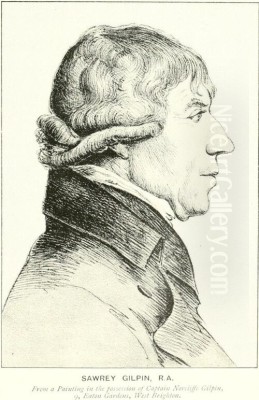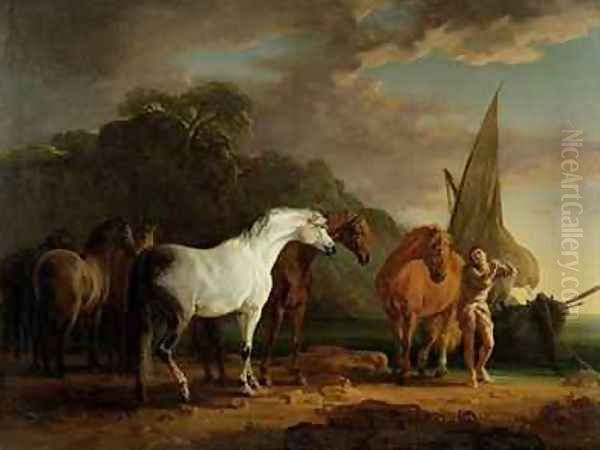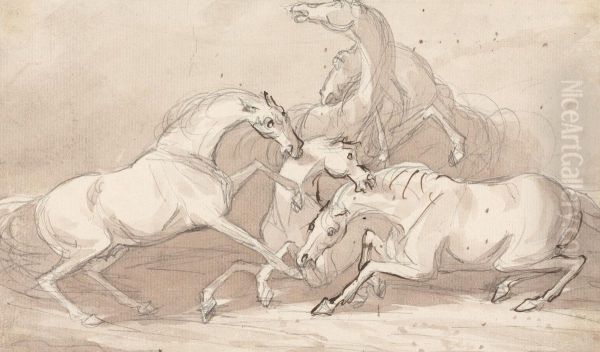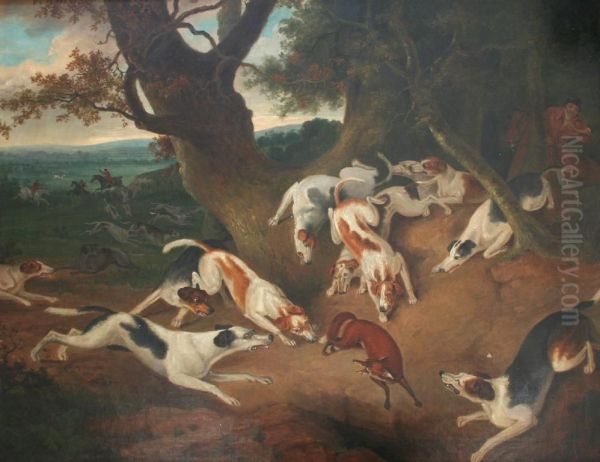
Sawrey Gilpin (1733-1807) stands as a significant figure in the history of British art, celebrated primarily as an animal painter, illustrator, and etcher. Flourishing in the latter half of the 18th century, Gilpin carved a distinct niche for himself, particularly renowned for his masterful depictions of horses and dogs. His work captured the grace, power, and spirit of the animal kingdom, contributing significantly to the development of animal painting in Britain during a period of burgeoning interest in both natural history and sporting life. Born into a family with artistic inclinations, his career trajectory took him from the provincial setting of Carlisle to the heart of London's art world, where he gained recognition, patronage, and ultimately, a place in the prestigious Royal Academy of Arts.
Early Life and Artistic Formation
Sawrey Gilpin was born in Carlisle, Cumberland, in 1733. His familial environment was conducive to artistic pursuits; his father, Captain John Bernard Gilpin, was a soldier but also an amateur artist. Furthermore, his elder brother was the Reverend William Gilpin, who would become widely known as a writer, clergyman, schoolmaster, and a key theorist of the Picturesque movement. This early exposure to art and aesthetic ideas likely nurtured Sawrey's innate talent and interest, which became evident from a young age.
Recognizing his potential, his family sent him to London in 1749, at the age of fourteen, to pursue formal artistic training. He was placed under the tutelage of Samuel Scott, a leading marine painter based in Covent Garden. Scott's expertise lay in seascapes and topographical views of London, offering Gilpin a solid grounding in the fundamentals of drawing and painting, particularly in capturing atmosphere and perspective. This apprenticeship provided the foundational skills upon which Gilpin would build his specialized career.
Developing a Specialization

Although Gilpin began his training under a marine painter, his passion gravitated strongly towards the depiction of animals. While studying with Samuel Scott, Gilpin frequently sketched the horses and carts that passed through Covent Garden market, honing his observational skills and developing a deep understanding of equine anatomy and movement. His focus soon shifted decisively away from marine subjects towards animal painting, with horses quickly becoming his primary subject and the cornerstone of his artistic reputation.
This dedication to animal subjects, particularly the horse, distinguished him early on. He spent considerable time sketching animals from life, visiting stables and observing animals in motion. This direct study allowed him to imbue his subjects with a sense of vitality and realism that surpassed mere anatomical accuracy, capturing their individual character and spirit. His ability to render the sleek coats, muscular forms, and dynamic poses of horses set his work apart.
Patronage and Early Success
Gilpin's talent did not go unnoticed. He attracted the attention of influential patrons, most notably William Augustus, Duke of Cumberland. The Duke, a prominent military figure and a keen sportsman with extensive stables, became a significant patron around 1758. He employed Gilpin at his residences in Newmarket, the centre of British horseracing, and later at Windsor Great Park. This patronage provided Gilpin with unparalleled access to study some of the finest horses in the country, further refining his skills and establishing his reputation as a premier equine artist.
During his time under the Duke's patronage, Gilpin produced numerous portraits of horses, often set against landscape backgrounds. Beyond royal patronage, Gilpin also received commissions from other members of the gentry interested in sporting art. For instance, he painted works for Colonel Thornton of York, a noted sportsman. One such commission likely included hunting scenes, such as the subject Death of the Fox, a theme popular among the landed gentry, showcasing his versatility within the animal and sporting genres. These commissions solidified his standing and provided financial stability.
Artistic Style and Technique
Sawrey Gilpin's artistic style is characterized by its elegance, dynamism, and sensitivity to the animal form. He excelled at capturing animals, especially horses, in motion, conveying a sense of energy and grace. His compositions are often harmonious, with careful attention paid to the interplay of light and shadow, which added depth and realism to his subjects. While perhaps not possessing the same rigorous anatomical precision sometimes attributed to his celebrated contemporary, George Stubbs, Gilpin was often considered superior in capturing the spirit, elegance, and 'genius' of the animal.

His approach seemed less focused on the purely scientific rendering of anatomy and more on the aesthetic qualities of movement, posture, and the interaction between animals or between animals and humans. He often depicted horses in groups, showcasing their social dynamics, or in dramatic scenes drawn from history or literature, allowing for expressive poses and compositions. His skill extended beyond horses to include dogs, cattle, and even exotic animals like tigers, always demonstrating a keen eye for their characteristic forms and behaviours.
Major Works and Themes
Throughout his long career, Sawrey Gilpin produced a considerable body of work exploring various themes centred around animals. Several paintings stand out as representative of his skill and interests. One notable example is Gulliver taking his final leave of the Land of the Houyhnhnms (c. 1769), inspired by Jonathan Swift's Gulliver's Travels. This work showcases his ability to integrate literary themes with his mastery of equine depiction, capturing the emotional narrative alongside the noble forms of the Houyhnhnms.
Other significant works include A Group of Horses (1792), demonstrating his skill in composing complex arrangements of animals within a landscape. Paintings like Two Greyhounds and a Mastiff highlight his proficiency in depicting dogs with equal sensitivity. He also tackled more dramatic subjects, such as Horses Frightened in a Thunderstorm or works depicting tigers, showcasing his ability to convey power and wildness. A piece titled Three Horses drawing a Roman Chariot, with Charioteer and other figures indicates his engagement with classical or historical themes, using animals to enhance the grandeur and action of the scene. His depictions of hunting scenes, like Death of the Fox, catered to the tastes of his sporting patrons.
Collaborations and Influence
Sawrey Gilpin occupied an important position within the British art scene, not only through his own work but also through his collaborations with prominent contemporaries. He frequently provided the animal figures for landscapes painted by other leading artists. Notable collaborators included the great landscape painter J.M.W. Turner, the portrait and conversation piece painter Johann Zoffany, and the landscape artist George Barret the Elder. In these collaborations, Gilpin's expertly rendered horses, cattle, or dogs would animate the scenes created by his colleagues, adding life and narrative interest to their compositions.

These partnerships underscore Gilpin's reputation as the go-to artist for animal subjects. His work served as a vital link between the earlier generation of sporting and animal painters, such as John Wootton and Peter Tillemans, and the subsequent generation who continued the tradition, including artists like John Frederick Herring Sr. Gilpin's ability to integrate animals seamlessly into diverse landscape settings contributed significantly to the richness of British painting during this period. He also interacted with other animal painters like Philip Reinagle and James Ward, who were part of the same artistic milieu.
Exhibitions and Recognition
Gilpin actively participated in the burgeoning exhibition culture of London. He began exhibiting with the Incorporated Society of Artists in 1762, showing works there regularly until 1783. His contributions primarily featured his favoured subjects: horses and other animals. His consistent presence at these exhibitions helped to build his public profile and attract further commissions.
From 1786 onwards, Gilpin shifted his focus to the Royal Academy of Arts, exhibiting there almost annually until his death in 1807. His work was well-received within the Academy, culminating in his election as an Associate of the Royal Academy (ARA) in 1795, followed swiftly by his election as a full Royal Academician (RA) in 1797. This prestigious honour signified his acceptance into the highest echelons of the British art establishment and acknowledged his significant contribution to the field, particularly in elevating the status of animal painting.
Teaching and Legacy
Beyond his own practice, Sawrey Gilpin also played a role in educating the next generation of artists. Among his pupils were George Garrard, who also became known for animal painting and sculpture, and potentially Thomas Gooch and Edwin Cooper, who followed similar artistic paths. It is also noted that his artistic inclinations were passed down within his family; his son, William Sawrey Gilpin (often confused with his uncle William), became a landscape painter and later a landscape gardener, and a daughter, Matilda, is also mentioned as having pursued art, suggesting a continuation of the family's creative legacy.
Gilpin's primary legacy lies in his contribution to British animal painting. He brought a new level of elegance and sensitivity to the genre, influencing subsequent artists who specialized in animal and sporting subjects. His emphasis on capturing the movement and spirit of the animal, combined with his technical skill, ensured his work remained admired. He successfully navigated the demands of patronage while maintaining his artistic integrity, leaving behind a substantial body of work that continues to be appreciated for its artistry and its insight into the relationship between humans and animals in 18th-century Britain.
The Gilpin Family Context

Sawrey Gilpin's artistic identity was shaped not only by his training and patronage but also by his family background, particularly his connection to his brother, William Gilpin. William was a key figure in developing and popularizing the theory of the Picturesque, an aesthetic ideal that emphasized roughness, irregularity, and visual interest in landscape, often advocating for the 'improvement' of nature to fit artistic principles. While Sawrey was primarily a painter of animals rather than pure landscapes, the intellectual climate fostered by his brother's ideas likely influenced his approach.
William Gilpin's emphasis on observation and the search for aesthetic harmony in nature may have resonated with Sawrey's own careful study of animal forms and his desire to create elegant compositions. Some sources suggest Sawrey shared a practical approach, believing in improving upon real scenes through artistic practice rather than strict adherence to theory, which aligns subtly with the Picturesque sensibility of enhancing natural beauty for artistic effect. This familial connection places Sawrey Gilpin within a broader cultural context concerned with aesthetics, nature, and representation.
Collections and Enduring Reputation
Sawrey Gilpin died in Brompton, London, in 1807, at the age of 74, leaving behind a significant artistic legacy. Today, his works are held in numerous prestigious public collections, attesting to his enduring importance in British art history. Major institutions housing his paintings and drawings include the Tate Britain in London, the Royal Collection Trust (with works likely at Windsor Castle), the Victoria and Albert Museum (which holds sketchbooks), and the British Museum.
His works are also found in the Fitzwilliam Museum in Cambridge and across the Atlantic at the Yale Center for British Art in New Haven, Connecticut, which holds his notable painting Gulliver taking his final leave of the Land of the Houyhnhnms. The Royal Academy of Arts in London also retains works, including sketchbooks, reflecting his long association with the institution. The presence of his art in these key collections ensures its accessibility for study and appreciation, securing his reputation as a leading animal painter of the Georgian era. Although sometimes seen in the shadow of George Stubbs, Gilpin's unique blend of elegance, dynamism, and sensitivity continues to earn him recognition.
Conclusion
Sawrey Gilpin remains a pivotal figure in the story of British animal painting. Emerging from the tutelage of a marine painter, he dedicated his career to capturing the essence of the animal kingdom, particularly the horse, with unparalleled grace and vitality. Through significant patronage, collaborations with leading artists like Turner and Zoffany, and active participation in London's exhibition scene, he established himself as a master of his genre. His election to the Royal Academy confirmed his status within the art establishment. While debates might place his anatomical precision relative to contemporaries like Stubbs, Gilpin's unique ability to convey movement, elegance, and the spirit of his subjects secured his distinct and lasting contribution. His works, preserved in major collections worldwide, continue to celebrate the beauty and dynamism of animals, reflecting the artistic and cultural preoccupations of 18th-century Britain.